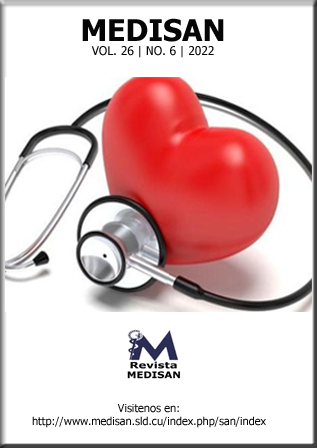Caracterización clinicoepidemiológica, diagnóstica e histopatológica de pacientes tratados con esofagectomía por cáncer de esófago
Palabras clave:
cáncer de esófago, factores de riesgo, diagnóstico, esofagectomía, histopatología.Resumen
Introducción: El cáncer de esófago se manifiesta clínicamente en etapas avanzadas y presenta gran letalidad.
Objetivo: Caracterizar a los pacientes operados de cáncer de esófago según variables epidemiológicas, clínicas, diagnósticas e histopatológicas.
Métodos: Se realizó un estudio observacional, descriptivo y transversal de 87 pacientes con cáncer de esófago, operados en el Servicio de Cirugía General del Hospital Provincial Docente Clinicoquirúrgico Saturnino Lora de Santiago de Cuba, en el periodo 2014-2018.
Resultados: Dicha afección predominó en pacientes del sexo masculino (94,2 %) entre los 65 y 74 años de edad (37,9 %); el tipo histológico más frecuente fue el carcinoma epidermoide (89,6 %) y la localización en el tercio medio (49,4 %). Los hábitos tóxicos que primaron fueron el tabaquismo (87,4 %) y el consumo de alcohol (75,8 %). La disfagia y la pérdida de peso se manifestaron en 73,5 y 66,6 % de la serie, respectivamente. El diagnóstico se realizó mediante imágenes, tales como esofagograma, tomografía contrastada de tórax, abdomen y pelvis; así como por medio de endoscopia y biopsia.
Conclusiones: Se demostró que los hombres son los más afectados y es más frecuente el diagnóstico en mayores de 60 años de edad. Se observó el vínculo con el hábito de fumar y el consumo de alcohol. La disfagia es el síntoma más común y tardío de la enfermedad. El estudio de las características clínico-histológicas de los pacientes con cáncer de esófago permite un adecuado enfoque diagnóstico de esta afección, así como el desarrollo de acciones de salud preventivas sobre los principales factores de riesgo identificados.
Descargas
Citas
2. Sabiston. Tratado de cirugía. Fundamentos biológicos de la práctica quirúrgica moderna. 21 ed. Barcelona: Elsevier; 2022.
3. Cora Estopiñan S, Avalos García R, del Valle Llufrio P, Vaanterpol Héctor M, Ramos Díaz D. Caracterización clínico-patológica del cáncer esofágico avanzado en el Hospital Universitario Comandante Faustino Pérez de Matanzas. Rev Méd Electrón. 2019 [citado 30/07/2022];41(2):382-96. Disponible en: http://www.revmedicaelectronica.sld.cu/index.php/rme/article/view/2940/4240
4. Acosta Hernández Y, Vanterpool Héctor M, Soares Menezes A. Caracterización clínico-histológica de pacientes con cáncer esofágico del Hospital Nacional “Guido Valadares”, Timor Oriental. Rev Inf Cient. 2022 [citado 30/07/2022];101(1):1-12. Disponible en: http://scielo.sld.cu/pdf/ric/v101n1/1028-9933-ric-101-01-e3765.pdf
5. Cuba. Ministerio de Salud Pública. Anuario Estadístico de Salud 2020. La Habana: MINSAP; 2021 [citado 30/07/2022]. Disponible en: https://salud.msp.gob.cu/wp-content/Anuario/Anuario-2020.pdf
6. Castellanos González JA, Mederos Curbelo ON, Barrera Ortega JC, Romero Díaz CA, Adefna Pérez RI, Leal Mursulí A. Caracterización de pacientes operados por cáncer del esófago en Cuba. Rev Cubana Cir. 2021 [citado 28/07/2022];60(4):e1191. Disponible en: http://scielo.sld.cu/scielo.php?script=sci_arttext&pid=S0034-74932021000400006&lng=es
7. Hernández Cortés K, Medina García C, Hernández Cortés N. Caracterización clínica, epidemiológica y anatómica del cáncer de esófago. Rev Cubana Med Gen Integr. 2020 [citado 28/07/2022];36(4):1-12. Disponible en: https://www.medigraphic.com/pdfs/revcubmedgenint/cmi-2020/cmi204k.pdf
8. Monier Martínez Y, León Columbié AR, Díaz Fondén J, Despaigne Guillot O, Rojas Columbié Y. Aspectos clinicoepidemiológicos, endoscópicos e histológicos en ancianos con cáncer de esófago. MEDISAN. 2022 [citado 28/07/2022];26(3):e4146. Disponible en: http://scielo.sld.cu/scielo.php?script=sci_arttext&pid=S1029-30192022000300003&lng=es
9. Zambrano Zambrano FC, Vélez Macías MA, Chacha Suscal NR, Basurto Macias GG, Pesantez Durán AF. Sintomatología y tratamiento en cada etapa del paciente con cáncer de esófago. RECIAMUC. 2020;4(4):263-72.
10. Vanterpool-Hector M, Sid-Motumise K, Acosta-Hernández Y, Avalos-García R, Corrales-Alonso S. Caracterización clínico-patológica del cáncer esofágico avanzado en Botsuana. Rev Inf Cient. 2021 [citado 23/07/2022];100(4):1-11. Disponible en: http://www.revinfcientifica.sld.cu/index.php/ric/article/view/3524
11. Encinas de la Iglesia MA, Corral de la Calle GC, Fernández Pérez R, Ruano Pérez A. Cáncer de esófago: particularidades anatómicas, estatificación y técnicas de imagen. Radiología. 2016 [citado 07/07/2022];58(5):352-65. Disponible en: https://www.elsevier.es/es-revista-radiologia-119-articulo-cancer-esofago-particularidades-anatomicas-estadificacion-S0033833816300741
12. Jáuregui Francia FT, Jáuregui Caycho L, Figueroa Bejarano MR, Jáuregui Figueroa MR, Purilla Janto JM. Manejo actualizado en el tratamiento quirúrgico del cáncer de esófago. Rev Fac Med Hum. 2018 [citado 07/07/2022];18(4):59-64. Disponible en: https://revistas.urp.edu.pe/index.php/RFMH/article/view/1732/1649
13. Mesa Izquierdo O, Martínez Martínez T, Macías Ochoa Y, Ramos Rodríguez AO, Escalona Ferro O. Caracterización y oportunidad del tratamiento quirúrgico en pacientes con cáncer de esófago. Rev Cubana Cir. 2021 [citado 28/07/2022];60(3):e1074. Disponible en: http://scielo.sld.cu/scielo.php?script=sci_arttext&pid=S0034-74932021000300001&lng=es
14. Ramírez R MA, Fluxá GF. Esófago de Barrett: Revisión de la literatura. Revista Médica Clínica Las Condes. 2015 [citado 28/07/2022];26(5): 557-64. Disponible en: https://www.sciencedirect.com/science/article/pii/S0716864015001200
15. Durruthy Wilson O, Piña Napal JC, Santana Álvarez J. Cáncer de esófago y virus del papiloma humano. Arch Méd Camagüey. 2012 [citado 29/07/2022];16(5):644-50. Disponible en: http://scielo.sld.cu/scielo.php?script=sci_arttext&pid=S1025-02552012000500014&lng=es
Publicado
Cómo citar
Número
Sección
Licencia
Esta revista provee acceso libre e inmediato a su contenido bajo el principio de que hacer disponible gratuitamente investigación al público, apoya aún más el intercambio de conocimiento global. Esto significa que los autores/as conservarán sus derechos de autor y garantizarán a la revista el derecho de primera publicación de su obra, el cuál estará simultáneamente sujeto a la licencia internacional Creative Commons Atribución 4.0 que permite copiar y redistribuir el material en cualquier medio o formato para cualquier propósito, incluso comercialmente, además de remezclar, transformar y construir a partir del material para cualquier propósito.





